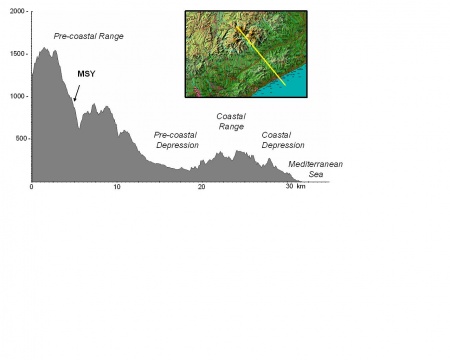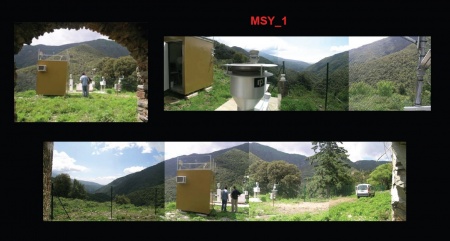DAURE
This Wiki is a repository of information about the DAURE field campaign to be conducted at an urban/rural site pair in Barcelona and Montseny (Catalonia, Spain) in winter and summer 2009. This is the main page about the study and focuses on the scientific aspects of the study. We have another Wiki page for the logistics and organization of the study.
Objectives
The objectives of this campaign is to characterize the sources of fine aerosols in the Barcelona region, with particular attention to carbonaceous aerosols. State-of-the-Art methods such as 14C and HR-ToF-AMS analysis have been applied or are starting to be applied to the source apportionment problem in Central Europe, but not yet in the Mediterranean region. There are reasons to believe that the results from Central Europe (dominance of biogenic and biomass burning in the organic aerosol) may not apply in the Mediterranean, and this campaign is a unique opportunity to evaluate this hypothesis (CSIC, UC, PSI, CEH, BSC, UPC,CIEMAT, UB, UGR, and other participant groups). Furthermore, Biogenic Volatile Organic Compounds emissions and concentrations in Barcelona and Montseny and their implications as sources of aerosols will be also investigated (CREAF).
The campaign is funded by a Accion Complementaria from the Spanish Ministry of Science (Querol group), the US National Science Foundation (Jimenez Group) including travel support from NSF-ORISE, and other agencies.
Sites
The campaigns should be carried out simultaneously at two sites of NE Spain in the Mediterranean Basin
- Site BCN will be inside Barcelona (CSIC. Located in the university campus in the western side of Barcelona close to Diagonal Avenue, one of the main traffic roads from the city. In this area we will install 2 monitoring cabins BCN_1 and BCN_2. The first consits of a conventional aerosol monitosing site containing CSIC instrumentation. BCN_2 is a small office trailer ready to install the arriving instruments (power to be discussed) and it is located only 5 m away from BCN_1.
Urban Background 41°23'24.01"N 02° 6'58.06"E
The station is located 10 m from a University Residence and around 300 m of our Institute of Earth Sciences ‘Jaume Almera’, CSIC. It is very convenient to book rooms at this residence a.s.a.p (see details below).
- Site MSY will be a rural mountain site at Montseny (~50 km away), ideally with the same measurements at both sites. In this area we seleceted 2 monitoring sites MSY_1 and MSY_2. The first consits of a conventional aerosol monitosing site containing CSIC instrumentation. MSY_2 is a traditional rural house plenty of space, with sleeping rooms, kitchen and very basic labs. CREAF has ge kindly allowed us to use this MSY 2 field laboratory. Spacial thanks to Javier Retana (director of CREAF)for facilitating all sort of actions to allow us organizing the measurements. This is ready to install the arriving instruments (up to 10 kW) and it is located only 200 m away from MSY_1.
Regional background MSY_1: CSIC aerosol monitoring station 41°46'45.63"N 02°21'28.92"E
MSY_2: Rural house with laboratory for DAURE 41°46'45.21"N 02°21'17.48"E
- Additionally there will be space enough to work with a conventional mobile unit (from PSI or from AQ local agencies. Note that at Montseny the unpaved mountain road is in poor condition, and has posed problems in the past.
Participant Groups
The following groups are likely to participate in this campaign, although in some cases this depends on funding.
- CSIC Host group: The aerosol research group at the Institute of Earth Sciences, CSIC in Barcelona, Spain (contact Xavier Querol)
- Fuinding for CSIC participation, some logistic expenses and for 14C analysis were obtained from the Spanish Ministry of Innovation and Science: Proyecto DOASUR: CGL2007-62505/CLI. Acción Complementaria DAURE CGL2007-30502-E/CLI, and Consolider-Ingenio project GRACCIECSD 2007-00067.
- Colorado Jimenez group at the University of Colorado-Boulder, USA
- CEH Edinmburg, Atmospheric Sciences [1], Scotland, UK (contact person Eiko Nemitz)
- PSI [2] Laboratory for Atmospheric Chemistry at the Paul Scherrer Institut, Switzerland
- BSC Barcelona Supercomputing Centre, Spain
- The CREAF [3], Spain (contact Josep Peñuelas). CREAF has ge kindly allowed us to use MSY 2 field laboratory. Special thanks are given to Javier Retana (director of CREAF)for facilitating all sort of actions to allow us organizing the measurements.
- CIEMAT [4], Spain, with continuous OC, EC and nitrate analysis (contact Begoña Artiñano)
- UB: Atmospheric Physics Group of the University of Barcelona, Spain [5]: Aerosol optical characterization from columnar radiometric measurements, Cimel sunphotometer, spectroradiometers and meteorological instruments (contact Jeroni Lorente)
- UPC: Department of Signal Theory and Communications (TSC) (Lidar experts) [6], Spain (contact Adolfo Comerón and Michaël Sicard)
- Possible participation:
- Granada University, Spain with column aerosols measurements
Instrumentation (only winter campaign)
The following instrumentation is planned to be working during the winter campaign (the summer one will be discussed later as a function of the first results):
BCN_1
- CSIC
- Optical counter for PM10, PM2.5 and PM1.
- 3 high volume samplers for PM10, PM2.5 and PM1: 12 to 24 h speciation of PM10, PM2,5 and PM1 including sulfate, nitrate, chloride, ammonium, OC, EC, Ca, Al, Fe, K, Mg, Mn, P, Ti, and 55 trace elements. Analysis will be performed after sampling with ICP-MS, ICP-AES, Sunset TO OC-EC, IC, seletive electrodes.
- Breakup of PM1 filter
- 1/4 for ICP-MS and ICP-AES (IJA)
- 1/2 for 14C analysis of EC and OC (PSI, selected samples)
- 1/4 for levoglucosan & dicarboxylic acids (Risto Hillamo)
- Breakup of PM2.5 filter
- 1/4 for ICP-MS and ICP-AES (IJA)
- 1/4 for levoglucosan & dicarboxylic acids (Risto Hillamo)
- 1/4 for lixiviate
- 1/4 is available
- Breakup of PM10 filter
- 1/4 for ICP-MS and ICP-AES (IJA)
- 1/4 for lixiviate
- 1/2 is available
- MAAP.
- Water CPC (without SMPS, we would appreciate if someone bring one).
- SO2, NOx, O3, CO (will be installed with 75% probability).
- Met-data available from Faculty of Physics (300 m from the station).
- Low volume sampler (Partisol) with denuder and QBQ for OC (with positive and negative artifact correction) and EC in PM2.5.
- Denuders for NH3 and HNO3 artefact determination. 2 PM2.5 low-volume samplers (1m3/h), with 24 hour samples.
- Determination of levels of levoglucosan on 24h filter samples by IC.
BCN_2
- PSI
- W-ToF-AMS.
- Another W-ToF-AMS will be available to performs mobile and stationary measurements at the same time
- 14C analyses on filters. 10 daily samples at MSY and 10 samples at BCN. For each sample 2 analysis, one for OC the other for EC. This will be repeated during both for winter and summer campaigns.
- 1 rotating drum impactors (2 hourly resolution for subsequent synchrotron-XRF at PSI).
- 1 aethalometer.
- 1 SMPS/calibration unit
- 1 APS
- Mobile laboratory (AMS, MAAP, FMPS, CO2, NOx, CO) to measure at different sites at the begining and at the end of the campaign
- CIEMAT
- Real time measurements of nitrate R&P 8400N (PM2.5)
- Real time measurements of sulfate (Thermo)
- Moudi sampler for speciation
- Low vol sampler for SEM-EDX analysis of aerosols
- UB
- Cimel sunphotometer.
- Spectroradiometers.
- Meteorological instruments.
MSY_1
- CSIC
- Optical counter for PM10, PM2.5 and PM1.
- 3 high volume samplers for PM10, PM2.5 and PM1: 12 to 24 h speciation of PM10, PM2,5 and PM1 including sulfate, nitrate, chloride, ammonium, OC, EC, Ca, Al, Fe, K, Mg, Mn, P, Ti, and 55 trace elements. Analysis will be performed after sampling with ICP-MS, ICP-AES, Sunset TO OC-EC, IC, seletive electrodes.
- Use of the filters for analysis would be exactly the same as described for BCN_1
- MAAP.
- Butanol CPC (without SMPS, we would appreciate if someone bring one).
- SO2, NOx, O3, CO (will be installed with 75% probability).
- Met-data available.
- Low volume sampler (Partisol) with denuder and QBQ for OC (with positive and negative artifact correction) and EC in PM2.5.
- Determination of levels of levoglucosan on 24h filter samples by IC.
- PSI
- 1 rotating drum impactors (2 hourly resolution for subsequent synchrotron-XRF at PSI).
MSY_2
- PSI
- 1/2 filter of PM1 for selecetd samples will be used for 14C analysis of EC and OC
- 14C analyses on filters. 10 daily samples at MSY and 10 samples at BCN. For each sample 2 analysis, one for OC the other for EC. This will be repeated during both for winter and summer campaigns.
- CIEMAT
- SMPS
- Low vol sampler for SEM-EDX analysis of aerosols
- UC-CEH
- ToF AMS
- Dust track
- CREAF
- BVOC emission rates. Leaf enclosure technique will be employed using LiCor 6400 Photosynthesis System to determine photosynthetic activity and BVOC emission flux at a given temperature, photosynthetic active radiation (PAR), relative humidity, and CO_2 concentration. Cuvette air samples will be drawn (pumped out) from the exhaust line into sampling tubes packed with adsorbents.
- Analysis of air samples C_5 to C_20 compounds will be determined. Air samples will be analyzed using gas chromatography / mass spectrometry at CREAF. In addition, scans of C_1 -C_20 VOCs will be conducted by sampling air with tedlar bags or canisters to be later analysed with PTR-MS (in case the PTR-MS itself can not be transported to the sites)
- Calculations of biogenic VOC emission and modeling emission fluxes will be calculated for different levels (1) leaf-and branch-scale, (2) canopy, and (3) landscape emission capacity model following standard algorithms with adjustments when appropriate.
BCN3
- BSC-UPC
- UPC
- Lidar measurements for PM upto 5km high each Monday and Thursday. Additionally, 2 more measurements/week around 01:00 UTC and 13:00 UTC, coinciding with CALIPSO passage over Barcelona.
ADDITIONALLY PLEASE PSI HAS TO CONFIRM:
- Molecular tracers and NMR spectral fingerprints (through collaborators in EUCARII)
Dates
If sufficient funding and personnel are available, we will conduct 2 campaigns to contrast summer and winter at the paired urban/rural sites.
Confirmed dates in Winter/Spring 2009
- 23-Feb-09 to 27-March-09, together with EMEP-2 campaign. PSI is available for sure and can bring HR-ToF-AMS. Also molecular tracers and spectral fingerprints.
Tentative Dates in Summer 2009
- Tentatively the last 3 weeks of Jul-09 and first week of Aug-09, to catch a summer period. (Eiko has a campaign 8-June to 8-July 2009 in the Netherlands, which prevents moving this time period earlier in time, if his instrument is used).
- Andre Prevot (Email on 14-Dec-2008): "We prefer a real summer campaign in 2009 over the autumn campaign during EMEP. The summer campaign could be anytime from May to August in our opinion. We have to wait to fix the dates until we know the dates for the campaign in Paris which is part of the Megacity EU project MEGAPOLI. We can come to Barcelona before or after the Paris campaign. In the summer campaign we can bring the ToF and eventually the Q-AMS. If we have another AMS at one of the fixed sites, we might bring the Q-AMS in our mobile van instead of putting it at a fixed site. (Molecular tracers and spectral fingerprints will not be available)"











